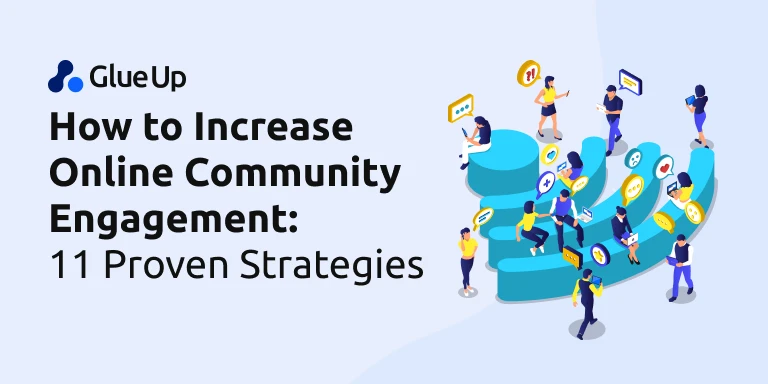
Last Updated: March 22, 2024
By leveraging online platforms, digital tools, and virtual events, you can easily connect and engage with your members, share information and resources, and expand your reach. You can not only post your photos, videos, and texts but ask your members to do it too. That’s where we should introduce user-generated content (UGC).
UGC connects the audience with the organization and its cause. It puts a human face on your company, influences audience behavior more than traditional marketing, and can help your team save time and money.
Sounds interesting? Let’s explore how going digital and using UGC can help you create a great community experience. You will also learn how to encourage the audience to generate and distribute this content.
Key Takeaways
- User-generated content (UGC) is recognized for its authenticity and trustworthiness compared to traditional advertising, as it originates from real users sharing genuine experiences.
- UGC transforms audience members from passive observers to active participants in an organization's narrative.
- Where traditional marketing tactics are becoming less effective, UGC stands out for its ability to build trust and influence decision-making.
- UGC offers a cost-effective alternative to traditional content creation, often requiring significant time and resources.
- Glue Up’s AI-powered community management software enhances UGC's utilization by providing a private social platform tailored to member-based organizations. The software facilitates deeper interaction within the community, allowing members to connect, share, and engage with one another securely.
Understanding User-Generated Content
UGC is often seen as more authentic and trustworthy than traditional advertising because it comes from real people with real experiences.
It’s genuine, powerful, and effective regardless of what industry you belong to.
Defining User-Generated Content
UGC is any form of content created by an individual or group of individuals rather than a corporation or business.
It can be images, video clips, text posts, and even website comments.
The most common examples are photos taken by ordinary people and shared on social media sites like Facebook, Twitter, and Instagram.
Sources of Community-Generated Content
Social media platforms

Do you have a social media account?
If yes, then it’s one of the easiest ways to find what people say about your organization and encourage them to tag you or use a specific hashtag when sharing related content.
Online communities
Another great place to find UGC is an online community or member forum.
Private online communities ensure a protected venue for knowledge sharing, collaboration, and communication among your members.
You can learn about their experiences and insights, answer questions, and gather feedback to improve in the future. These opportunities enable you to facilitate meaningful engagement and foster a sense of belonging.
Member surveys
If you want to get UGC faster, ask your audience to develop it.
It can be testimonials or feedback on your organization’s activities or events. Then you can place quotes on social media, a website, or marketing materials.
Events
If you organize events, you can incentivize attendees to post photos or videos and repurpose them as UGC.
4 Benefits of User-Generated Content Marketing
1. Authenticity and Credibility

Why is UGC so influential? It’s more authentic than anything else out there. As statistics show, authenticity is crucial to 90% of people when choosing whom to support.
UGC is about real people sharing their experiences, thoughts, and feelings on products, services, or activities they participated in. This type of content can be a great way to humanize your company.
It can show members that there are actual people behind the company name. And it will help you build stronger relationships with your audience, for example, donors in the case of nonprofit organizations.
2. Establishing Loyalty and Community Growth
UGC lets your audience become active participants in your organization’s activities. They can not only see how you contribute to the community but build a more meaningful life together. This social interaction can increase loyalty, ensure community building, and promote a sense of belonging.
Showcase UGC to spark conversations between the organization and the audience, building a stronger, more engaged community.
3. Building Trust and Influencing Decisions
Traditional marketing strategies and ads have less impact on the audience than before. That’s why organizations seek natural methods of promoting their ideas and values.
Due to the increasing role of social media in everyday life, content from real people outperforms traditional advertisements in terms of credibility.
UGC lets you harness the power of personal recommendations and create a deeper connection with your audience. Think of it as a digital version of word-of-mouth advertising. Incorporating UGC into your strategy can build trust and tell your story more authentically.
4. Cost-Effective and Adaptable

Consider everything that goes into a professional photo shoot:
- Finding a creative team and photographer;
- Selecting models;
- Renting a venue;
- Waiting for an editor to process and publish photos, etc.
It requires a lot of time and money, and there is no guarantee it will appeal to your audience. If you operate on a tight budget, UGC can solve problems with the high costs associated with content creation and scaling.
Use visuals and texts from your community. The best part is that they are usually free. But even if you cooperate with public figures, they may be open to non-paid partnerships and making collaborative content, ensuring significant cost savings.
Types of User-Generated Content
Now that we’ve defined UGC and its potential for community building let’s review some of its popular types. User-generated media is available in various formats, making it easy to find the ideal fit for your niche, for example:
- Visual content: photos and videos, immersing others into the real-life experience with your organization;
- Testimonials: written statements, videos, or even audio recordings from current or past members of the organization about their experiences and the benefits they have gained from being a member;
- Reviews: similar to testimonials, but you have less control over user-generated feedback. Reviews also usually appear not on corporate websites but on external platforms, such as Google Reviews, Yelp, or TrustPilot;
- Ratings: a numerical score or star rating system used to evaluate the overall quality of an organization;
- Social media posts: members’ content on Instagram, Facebook, LinkedIn, Twitter, and other social sharing platforms.
Examples of Best User-Generated Content
Let’s look at some prominent organizations using UGC for community building.
1. #GivingTuesday
Screenshot taken on the official GivingTuesday Instagram account
#GivingTuesday is a global movement that started in 2022.
It unites people worldwide who donate, help others, and raise awareness. All you need is to do something good and share it on social media with the hashtag #GivingTuesday.
2. #Movember
Screenshot taken on the official Movember website
This initiative aims to tell the world about men’s health issues such as prostate cancer, testicular cancer, and mental health. Members can choose their activity, for example:
- Grow a mustache
- Run or walk 60 miles
- Hold an event
- Choose an adventure challenge
People do it to raise money to prevent men’s diseases and attract more attention to the campaign.
3. #TaketheMaskOff
Screenshot taken on the official Neurodivergent Rebel Instagram account
This campaign strives to promote understanding of autism and its masking. Members publish their stories about autism under the hashtag #TakeTheMaskOff, which you can observe in the screenshot below.
4. #SmallBusinessSaturday
Screenshot taken from Instagram
As customers begin active shopping in November, local stores want to increase traffic during this season. That’s how Small Business Saturday started.
Promoted by American Express, it encourages people to buy at local and small stores. Consumers tell about their experiences on social media using the hashtag #SmallBusinessSaturday.
Strategies for Obtaining Community-Generated Content
1. Request Permission and Give Credit
If your organization has been functioning for some time, there is a high chance that users already publish related content. Incorporate what people are saying into your marketing strategy.
For this purpose, you may need social listening or other dedicated tools, which we’ll discuss further.
Suppose you spotted a post mentioning you. You can’t simply take the photo and repurpose it on your account. Why? Because it may irritate users and even lead to copyright issues.
Here are two things to remember when curating content:
- Contact the author and request permission to use the content on your website or social media accounts. Engage members through email marketing or direct messages to inform them about your desire to share the post with the broad community.
- Indicate the original creator with clear attribution. You can tag them in the post or specify whether you use their words, images, or both.
Following these guidelines creates a win-win situation. You can satisfy the content creator by showing your appreciation for their posts.
You can also demonstrate to others that the text or visuals come from a real person, not your marketing team.
2. Be Clear About the Desired Content
What if you haven’t found anything online? You can request the audience to produce the desired content. In this case, you have more control over the posts appearing on your website or social media accounts.
Specify your expectations to make it easy for followers to provide information aligned with your needs. You can ask them to post on social media. Or you can get specific about the needed form of community-generated content, such as testimonials or videos.
After all, there are so many ways to shoot a clip or take a photo. For example, you may want to see pictures from an event with your logo or with certain people. Tell the community about it. It also applies to UGC in the text form.
Indicate the word count, the topic, or anything. Note that you shouldn’t limit users to leaving only favorable feedback. They should express genuine emotion with some recommendations on your part, not write a fake review.
3. Create Incentives for User Participation

People need a compelling purpose to invest time in developing content. What would you give them in exchange for participating in your UGC program?
Here is how member-based organizations can encourage people to publish community-driven content:
- Non-tangible rewards like recognition and acknowledgment
- Exclusive access to specific events, webinars, or courses
- Swag items like a branded mug, t-shirt, keychain, or discounts
- Running a structured contest with a prize, such as a cash prize, a gift card, or a free membership
- Personalized thank-you notes or emails
- The opportunity to co-create content, for example, participate in interviews or podcasts or write guest blog posts
- Points or badges
A member-based organization can collaborate with an online retailer and reward members for distributing UGC. Why should you consider it?
Such collaboration provides benefits for both your organization and the eCommerce partner. It not only increases conversion rate for the eCommerce partner but elevates your members’ experience as well. This ultimately leads to increased visibility, and involvement.
4. Set Goals and Develop a Plan
Every step should lead to some results. That’s why you should measure various metrics and key performance indicators (KPIs) to understand where you move with your user-generated campaigns.
To specify the indicators, you need to formulate your goals first. Once you’ve identified what you want to achieve, track the following KPIs:
- Impressions
- Reach
- Organic traffic
- Followers on social media
- Total interactions, likes, and comments
- The amount of created posts
- Click-through rates
And don’t forget to express your gratitude to the contributors.
5. Collaborate with Influencers
Collaborating with influencers to generate user-generated content (UGC) is a powerful strategy for boosting engagement and visibility.
Partner with celebrities and individuals who resonate with your cause. As 44% of influencers are willing to work with a brand if it is relevant to their audience, team up with such influencers and benefit from their influence to encourage a wide range of interactive content.
Here are some effective ways to collaborate with influencers to generate UGC:
- Challenges and Contests: Influencers can announce challenges and contests on their social media platforms, inviting their followers to participate.
- Live Q&A Sessions: Hosting live Q&A sessions with influencers offers a direct and interactive way for fans to engage with your brand.
- Reviews and Tutorials: Influencers' reviews have power. As 37% of consumers say they would trust any review or recommendation from social media personalities they folow. Thus, influencers who share honest reviews or create tutorials about your products or services can be highly persuasive.
- Promoting UGC Contests: Influencers can play a crucial role in promoting UGC contests, where followers are encouraged to submit their own content under a specific theme or hashtag.
- Sharing User-Generated Content: When influencers share UGC from their followers, it validates and appreciates the effort of their audience.
6. Showcase User Success Stories
Sharing user success stories is an effective strategy to boost community engagement. When current users see real-life testimonials and success stories from other members or customers, it not only validates their decision to engage with your brand but also boosts their confidence in your products or services.
These stories offer firsthand insights into the positive experiences and outcomes that others have achieved, making the value of your offerings more relatable.
Moreover, showcasing success stories can inspire other members of your community to come forward and share their own experiences. It creates a virtuous cycle of positive feedback and content generation that enriches your brand's narrative and builds a stronger, more connected community.
When people see that their contributions are valued and can make a difference or inspire others, they are more likely to contribute their own stories, thereby creating an environment of mutual support and engagement.
7. Provide Tools and Resources
To encourage and facilitate more user-generated content (UGC), equipping your members with the tools and resources they need to create engaging and high-quality content is beneficial.
Providing these resources creates a strong member community and guarantees that the content they produce aligns with your brand's standards and goals.
Here are some strategies to provide your members with the necessary tools and resources:
- Content Creation Guides: Offer guides or tutorials that cover best practices for creating content including tips on storytelling, photography, video production, and post-editing.
- Templates and Design Tools: Provide access to templates and design tools that members can use to create graphics, videos, or other visual content. Tools that allow for easy customization can help users produce professional-looking content without needing extensive design skills.
- Content Ideas and Prompts: Regularly share content ideas or themes to inspire your community members, help them overcome creative blocks, and encourage the production of relevant and engaging content.
- Brand Assets: Make your brand assets (such as logos, brand colors, and fonts) available to your members, ensure consistency across user-generated content, and reinforce your brand identity.
- Hashtag and Tagging Guidelines: Educate your members on the importance of using specific hashtags or tagging your brand in their posts.
- Feedback and Recognition Programs: Establish a system where members can receive feedback on their content from peers or your team.
- Accessible Platforms for Sharing: Ensure that there are easy and accessible platforms or forums where members can share their content.
Read more: Member Appreciation Ideas: Different Ways to Thank Your Members
Tools for Managing User-Generated Campaigns
It can be time-consuming to compile all content by yourself. So we present some tools, UGC platforms, and social listening solutions to streamline your user-generated content strategies.
1. Glue Up Community Management Software

Glue Up community management software is a private social media that helps you interact with your community more deeply than conventional social media.
It is exclusively designed for member-based organizations like yours so your members can take advantage of all the benefits of the community without feeling vulnerable to security breaches.
Furthermore, they can build professional relationships through the member directory, connect on 1:1 calls and share their digital business cards with other community members.
If you are interested to know more about Glue Up, get a demo here.
2. Determ
Screenshot taken on the official Determ website
Determ is another tool that provides real-time monitoring of online mentions of your name, including articles, hashtags, or comments.
3. Hootsuite Insights
Screenshot taken on the official Hootsuite website
It’s a social listening tool that shows user sentiment and trust based on mentions of organizations across social networks.
4. Yotpo
Screenshot taken on the official Yotpo website
Yotpo is a tool for tracking members’ reviews, photos, and videos. It integrates with Google and Facebook and lets you combine user visuals and comments to display on your website.
FAQs
1. Why Do Marketers Utilize User-Generated Content?
People will more likely choose what others recommend to them. Why? We believe in real-life experiences more than marketing materials, even though user-generated content isn’t professionally created. This is known as social proof.
2. Do You Need Permission Before Using UGC?
Yes, you need to ask for consent before republishing something. Engage with individuals through direct messages or the comment section to establish a connection based on shared experiences.
3. What Functions Do User-Generated Content Strategies Serve?
Community-driven content is a valuable information source for organizations and potential and existing members. It can build trust among newcomers and improve the organization’s reputation. Current members may also positively react to UGC, increasing engagement, loyalty, and retention.
—----------------------------------------------------------------------------------------------------------------------------
Building a flourishing community is crucial for member-based organizations in the digital era. Today, staring at a screen for hours on end is commonplace.
In 2022, the typical US adult used their mobile devices for 4 hours and 29 minutes daily. And this figure is anticipated to increase even further, reaching 4 hours 35 minutes in 2023. That’s more than 30 hours every week!
Such rapid growth in popularity lets companies communicate directly with the audience and develop stronger bonds with devotees. That’s why member-based organizations should also go digital to appeal to their community.
User-generated content can help you foster a sense of belonging and connection among your members, leading to higher member engagement and satisfaction. We’ve looked at how to leverage user-generated content as one of the community-building tactics for your organization.
Now that you know how to engage your members with UGC, employ it with powerful engagement software and see your community thrive!



